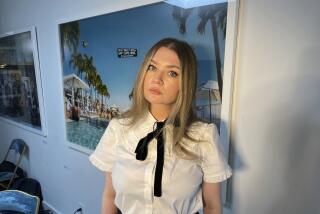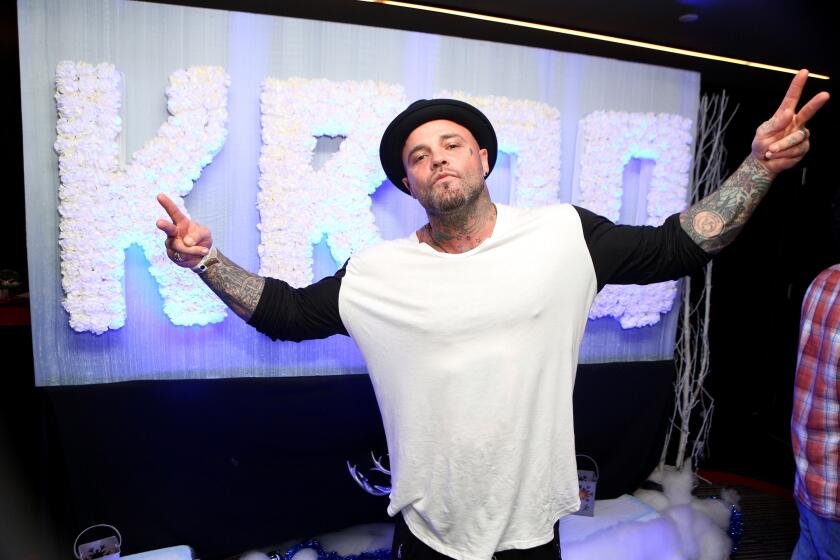‘Come Fly Away’ with Twyla and Frank
I’m the girl in the blue dress dancing on Frank Sinatra’s hat. I’m also on a key chain and a magnet. I’m not in the production of Twyla Tharp’s musical “Come Fly Away” that’s reaching the Pantages Theatre this week, but I’m proud my image is being used for publicity. There we are, my trusty partner and I, locked in a cameo dance embrace. My knee is wrapped faithfully around his waist. We are staring at each other’s noses. I’ve seen this pose replicated over and over during the credits for “Dancing With the Stars.” I understand why the “Come Fly Away” producers continue to use it; it’s kind of perfect.
The woman is off-balance, sending all her weight toward her partner, who she knows will catch her, and maybe whisper something into her ear or stroke her thigh. She looks swept away. During the Broadway run at the Marquis Theatre, I stood in this pose on a poster 30 feet tall. I used to get a cheap thrill seeing pedestrians suddenly pairing off and getting their photo taken with John Selya and me in flagrante dance-licto.
I learned that pose from Twyla and John two years ago in a sweaty attic studio at Hunter College on Lexington and 68th Street. I showed up before official rehearsals began for an informal discovery phase of what was originally called “Come Fly With Me,” to give myself an opportunity to work out in a sort of Twyla boot camp.
Twyla searched high and low for someone to partner with John. When she chose me, I was thrilled to finally work with her. She asked for my commitment with no agenda other than that. How could I have known that in less than a year, I’d be starring on Broadway, dancing backward and in heels? For the last 12 years (plus one as an apprentice), I had performed barefoot, usually wearing a Lycra unitard for the Merce Cunningham Dance Company. Merce taught me how to hold myself up in almost any position and how to count the timing of a dance phrase to the second without music. Neither of these skills proved transferable to Twyla’s style.
Why did she come to me? One dance insider told me that Misha (Mikhail Baryshnikov) had suggested it. I thought perhaps she’d read the article in the New York Times that I and two other dancers in Merce’s company were being unceremoniously fired. But it turned out that one of our mutual friends, Sue Weil, ex-wife of Robert Rauschenberg (and the Sue of “Sue’s Leg,” a 1975 dance by Twyla), had suggested it.
I suspect the reasons she hired me after that are simple. She likes to get into the skin of her dancers, feel what it’s like to move with them. She’s very hands on. In “Come Fly Away,” she worked with dancers whose veins course with the experience of American Ballet Theatre, the Royal Ballet, Alvin Ailey, Martha Graham and Cunningham. She truly loved Merce. Through my body, she got to see what he’d been up to all these years.
A few weeks before Merce died in July 2009, I got to tell him how it felt to be picked up and held high in the air to the music of Frank Sinatra. He was delighted.
Working with Tharp
That month, Twyla put me through paces that were specific and odd when you considered her nearly 50-year canon of choreography. Her warm-up included aspects of yoga, ballet, isometrics and movements that reminded me of Jazzercise. We also resisted gravity in every plane possible; on the floor, against a wall, against each other. Twyla leaned into me, hard, asking me to push back. I was relieved when she said, “Better than some.”
After the first few days, my partner showed up from his summer vacation, glowing with sun and rest. John usually looks like that due to a fierce devotion to things that make him sweat (ballet, Bikram yoga) and things that make him happy (surfing, his girlfriend). It was clear immediately that he and Twyla had an intuitive connection. Before she finished a direction, he had already performed it. And likewise, she listened eagerly to his suggestions. In essence, I had two directors. By the end of the first day of dancing with John, my dance-o-meter went off the chart. Twyla had choreographed an entire dance for us to Frank’s voice. I was lifted 10 feet off the ground and put down all right every time (a first in my adult life). Twyla said she was very proud of our partnership.
The feeling could not have been mutual for John. In the early rehearsals, I succeeded in getting my feet pummeled to imminent toenail loss on both the right and the left. As the weeks wore on, the bruises on my legs and the telltale blood and pus through my soft ballet shoes (I hated wearing even those) were not Twyla’s happy-making sight. She was concerned and very patient with my learning curve, but the day came when the real shoes had to go on. Twyla wanted me to be all babe, 3-inch heels forward, walking a seductive tight rope. The first step toward learning how to play the character, Babe, was learning how to walk in her shoes.
So off I went to the first of a dozen shoe interventions. Phil LaDuca of LaDuca Shoes (Liza Minnelli’s feet have graced his soles) gave me the first pair. After his assistants fit me, he said, and I’m not joking, “Don’t worry, doll, we’ll get you from barefoot to Broadway.” I wore them for almost every rehearsal and performance after that. But I also sat down weekly with a third-generation cobbler in Manhattan’s garment district. The man handled my foot from more angles than are decent in an attempt to solve the problem that my right foot (Size 71/2) and left foot (Size 7) present. My feet and ankles are super flexible, so the shoe couldn’t be too much of that. But I had to be able to feel the stage with my metatarsals, so pliability was important. Pirouettes using only the front part of the foot leave little room for error. And the shoe had to look good.
I continued wearing my LaDuca shoes while the saga continued. The blue dress was crying out for some Cadillacs. Finally, halfway through our Broadway run, a prototype was completed. It was shiny and blue with silver fenders. The shoe premiered at the 2010 Tony Awards. If the camera angle was slightly wider, you would have seen me slide into the wings after a jeté that didn’t stop where it landed — it just kept going. I never wore the shoe again. After that, I continued wearing the serviceable 23/4-inch spray-painted LaDuca with super-supportive straps across the arch. Mr. LaDuca came through on his promise.
Broadway debut
About four months into working with Twyla, after we’d finished our out-of-town tryout at the Alliance Theatre in Atlanta, she called, asking me to dance on Broadway. I sat down on the edge of my bed. I could only say, “Yes, I’d like some more time with the girl in the blue dress.” On March 25, 2010, I made my Broadway debut by walking 10 steps down a glistening staircase wearing a 5-pound silk organza boa (the feather boa was axed because it shed) and those heels.
I continued with the dancer’s routine of going to class (ballet) and physical therapy, with some Pilates thrown in to keep my back from bending in two during our dozen nightly overhead lifts. I was the sit-up queen; John was the push-up king. My favorite preshow warm-up was onstage, just me and some of the musicians who would come early and jam. I’d do a kind of barefoot, all-four-limbs improv covering the whole stage. Sometimes John played the bongos.
The show ran for more than 200 performances; every night except Monday was spent onstage. People came to see it from all walks of my New York life. My second-floor dressing room became a reception area three or four nights a week. My friends and family wanted to celebrate the show with the same happy gleam in their eyes usually reserved for a new bride. I poured wee drams of Lagavulin into their outstretched sippy cups and we toasted. And ate together, usually the first of my two dinners a night: steak at Frankie and Johnnie’s; egg salad, oysters and martinis at Bar Centrale (where tables got easier each week to reserve). One night, Patti Lupone breezed through the Bar Centrale doors and performed a most gracious diva bow in my general direction. I felt like the toast of the town for the two seconds it took her to bend her royal Broadway knees.
My character, Babe, grew on me. I knocked myself out researching dozens of femme fatales in popular culture played by such ladies as Mae West, Gwen Verdon, Ann-Margret, Ava Gardner. Being Babe was all about the walk, the gestures and the perfect bias-cut in blue silk. Each night, I caught a glimpse of myself before going onstage and knew that Babe was here. Kay, my dresser, made sure of it. She strapped me into the elaborate underpinnings of my dress, made sure I had all my bling, grabbed me a last-minute juice box, checked my makeup — like a big sister before an important date.
At “Places call,” the whole cast moved behind the curtain, listening to the band’s last preshow check. The male dancers worked off their steam with a pirouette competition; seven, eight or nine rotations at a time. I stretched my feet into the cold straps of my shoes and found the rhythm of my hips under the blue dress. Then, with one smack on the lips from Babe to Chanos (Matt Dibble, still going strong on the tour), we climbed up the vertical ladder leading to the stairs, and off we went. An hour and a half later, we headed straight downstage in a triumphant “step, touch” to Frank’s insistence that it’s “up to you, New York, New York!” The blue silk halter around my neck gradually etched a groove where it rested in between my cervical vertebrae.
On closing night, I left the dress hanging for Kay in my dressing room. In the year since, a few shows have come and gone at the Marquis. There’s no trace of the 30-foot posters of four tempestuous dancing couples. They don’t even display the poster in the ground floor gift shop anymore. I saw Stephen Sondheim’s “Follies” there a few weeks ago. The fading memories and fortunes of stage performers in that show would have been a distant theme to me a year ago. But now I’m part of a culture — I’m one of the legions of “the girls upstairs.”
I recently finished a series of performances downtown; the opposite of Broadway. Many of my old castmates surprised me by attending. They’ve moved onto the next job or teaching gig. The tour must look very different without us, but not significantly. Twyla started working on these dances more than 20 years ago. The dancers and the theaters are adding up but the dances exist similar to Frank’s gift — somewhere outside of time. I hear Babe now wears a red dress. That’d make a nice key chain too.
More to Read
The biggest entertainment stories
Get our big stories about Hollywood, film, television, music, arts, culture and more right in your inbox as soon as they publish.
You may occasionally receive promotional content from the Los Angeles Times.










